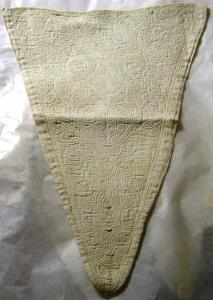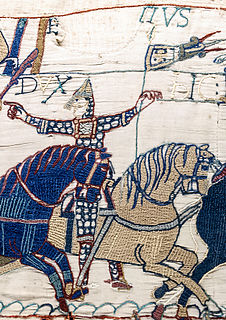
Embroidery is the craft of decorating fabric or other materials using a needle to apply thread or yarn. Embroidery may also incorporate other materials such as pearls, beads, quills, and sequins. In modern days, embroidery is usually seen on caps, hats, coats, overlays, blankets, dress shirts, denim, dresses, stockings, and golf shirts. Embroidery is available in a wide variety of thread or yarn colour.

Hardanger embroidery or "Hardangersøm" is a form of embroidery traditionally worked with white thread on white even-weave linen or cloth, using counted thread and drawn thread work techniques. It is sometimes called whitework embroidery.

A quilt is a multi-layered textile, traditionally composed of two or more layers of fabric or fiber. Commonly three layers are used with a filler material. These layers traditionally include a woven cloth top, a layer of batting or wadding, and a woven back combined using the techniques of quilting. This is the process of sewing on the face of the fabric, and not just the edges, to combine the three layers together to reinforce the material. Stitching patterns can be a decorative element. A single piece of fabric can be used for the top of a quilt, but in many cases the top is created from smaller fabric pieces joined together, or patchwork. The pattern and color of these pieces creates the design.

Crewel embroidery, or crewelwork, is a type of surface embroidery using wool. A wide variety of different embroidery stitches are used to follow a design outline applied to the fabric. The technique is at least a thousand years old.

The term "crazy quilting" is often used to refer to the textile art of crazy patchwork and is sometimes used interchangeably with that term. Crazy quilting does not actually refer to a specific kind of quilting, but a specific kind of patchwork lacking repeating motifs and with the seams and patches heavily embellished. A crazy quilt rarely has the internal layer of batting that is part of what defines quilting as a textile technique.
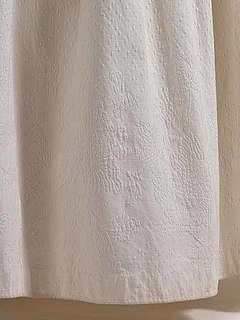
Piqué, or marcella, refers to a weaving style, normally used with cotton yarn, which is characterized by raised parallel cords or geometric designs in the fabric. Piqué fabrics vary from semi-sheer dimity to heavy weight waffle cloth. Twilled cotton and corded cotton are close relatives.

A tea gown or tea-gown is a woman's dress for informal entertaining at home. These dresses, which became popular around the mid-19th century, are characterized by unstructured lines and light fabrics. Early tea gowns were a European development influenced by Asian clothing and historical approach from the 18th century which led to the renaissance time period of long and flowing sleeves. Part of this European sense of fashion came from the Japanese kimono.

Candlewicking, or Candlewick is a form of whitework embroidery that traditionally uses an unbleached cotton thread on a piece of unbleached muslin. It gets its name from the nature of the soft spun cotton thread, which was braided then used to form the wick for candles. Motifs are created using a variety of traditional embroidery stitches as well as a tufted stitch. Subject matter is usually taken from nature - flowers, insects, pine trees, and so on, Other traditional motifs resemble Pennsylvania Dutch or Colonial American designs. Modern designs include colored floss embroidery with the traditional white on white stitching.
The manufacture of textiles is one of the oldest of human technologies. To make textiles, the first requirement is a source of fiber from which a yarn can be made, primarily by spinning. The yarn is processed by knitting or weaving, which turns yarn into cloth. The machine used for weaving is the loom. For decoration, the process of colouring yarn or the finished material is dyeing. For more information of the various steps, see textile manufacturing.
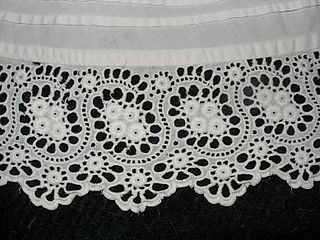
Cutwork or cut work, also known as punto tagliato in Italian, is a needlework technique in which portions of a textile, typically cotton or linen, are cut away and the resulting "hole" is reinforced and filled with embroidery or needle lace.

The straight or running stitch is the basic stitch in hand-sewing and embroidery, on which all other forms of sewing are based. The stitch is worked by passing the needle in and out of the fabric at a regular distance. All other stitches are created by varying the straight stitch in length, spacing, and direction.
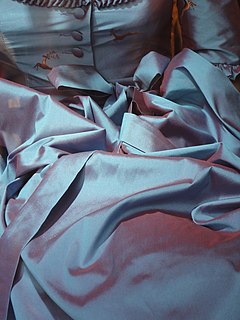
Shot silk is a fabric which is made up of silk woven from warp and weft yarns of two or more colours producing an iridescent appearance. A "shot" is a single throw of the bobbin that carries the weft thread through the warp, and shot silk colours can be described as "[warp colour] shot with [weft colour]." The weaving technique can also be applied to other fibres such as cotton, linen, and synthetics.

English embroidery includes embroidery worked in England or by English people abroad from Anglo-Saxon times to the present day. The oldest surviving English embroideries include items from the early 10th century preserved in Durham Cathedral and the 11th century Bayeux Tapestry, if it was worked in England. The professional workshops of Medieval England created rich embroidery in metal thread and silk for ecclesiastical and secular uses. This style was called Opus Anglicanum or "English work", and was famous throughout Europe.

The term Provençal quilting, also known as boutis, refers to the wholecloth quilts done using a stuffing technique traditionally made in the South of France from the 17th century onwards. Boutis is a Provençal word meaning 'stuffing', describing how two layers of fabric are quilted together with stuffing sandwiched between sections of the design, creating a raised effect. The three main forms of the Provençal quilt are matelassage, piqûre de Marseilles, and boutis. These terms, along with trapunto are often debated and confused, but they are all forms of stuffed quilting associated with the region.
Sewing is the craft of fastening or attaching objects using stitches made with needle and thread. Sewing is one of the oldest of the textile arts, arising in the Paleolithic Era. Although usually associated with clothing and household linens, sewing is used in a variety of crafts and industries, including shoemaking, upholstery, sailmaking, bookbinding and the manufacturing of some kinds of sporting goods. Sewing is the fundamental process underlying a variety of textile arts and crafts, including embroidery, tapestry, quilting, appliqué and patchwork.

Bizarre silks are a style of figured silk fabrics popular in Europe in the late 17th and early 18th centuries. Bizarre silks are characterized by large-scale, asymmetrical patterns featuring geometrical shapes and stylized leaves and flowers, influenced by a wave of Asian textiles and decorative objects reaching the European market in these decades. Bizarre silks were used for both clothing and furnishings. As a description, the term was first used by Dr. Vilhelm Sloman in the title of a book, Bizarre Designs in Silks published in 1953 in Copenhagen.

A close-bodied gown, English nightgown, or robe à l'anglaise was a women's fashion of the 18th century. Like the earlier mantua, from which it evolved, the back of the gown featured pleats from the shoulder, stitched down to mould the gown closely to the body until the fullness was released into the skirt. Through the 1770s, the back pleats became narrower and closer to the center back, and by the 1780s these pleats had mostly disappeared and the skirt and bodice were cut separately. The gown was open in front, to reveal a matching or contrasting petticoat, and featured elbow-length sleeves, which were finished with separate frills called engageantes.

A caraco is a style of woman's jacket that was fashionable from the mid-18th to early 19th centuries. Caracos were thigh-length and opened in front, with tight three-quarter or long sleeves. Like gowns of the period, the back of the caraco could be fitted to the waist or could hang in pleats from the shoulder in the style of a sack back. Caracos were generally made of printed linen or cotton.

Shoe buckles are fashion accessories worn by men and women from the mid-17th century through the 18th century to the 19th century. Shoe buckles were made of a variety of materials including brass, steel, silver or silver gilt, and buckles for formal wear were set with diamonds, quartz or imitation jewels.

Colcha embroidery from the southwest United States is a form of surface embroidery that uses wool threads on cotton or linen fabric. During the Spanish Colonial period, the word colcha referred to a densely embroidered wool coverlet. In time, the word also came to refer to the embroidery stitch that was used for these coverlets, and then began to be used on other surfaces. The colcha stitch is self-couched, with threads applied at a 45-degree angle to tie down the stitch. Originally, the wool threads were dyed naturally, using plants or insects, such as cochineal. Both materials used and design motifs have varied over time.


